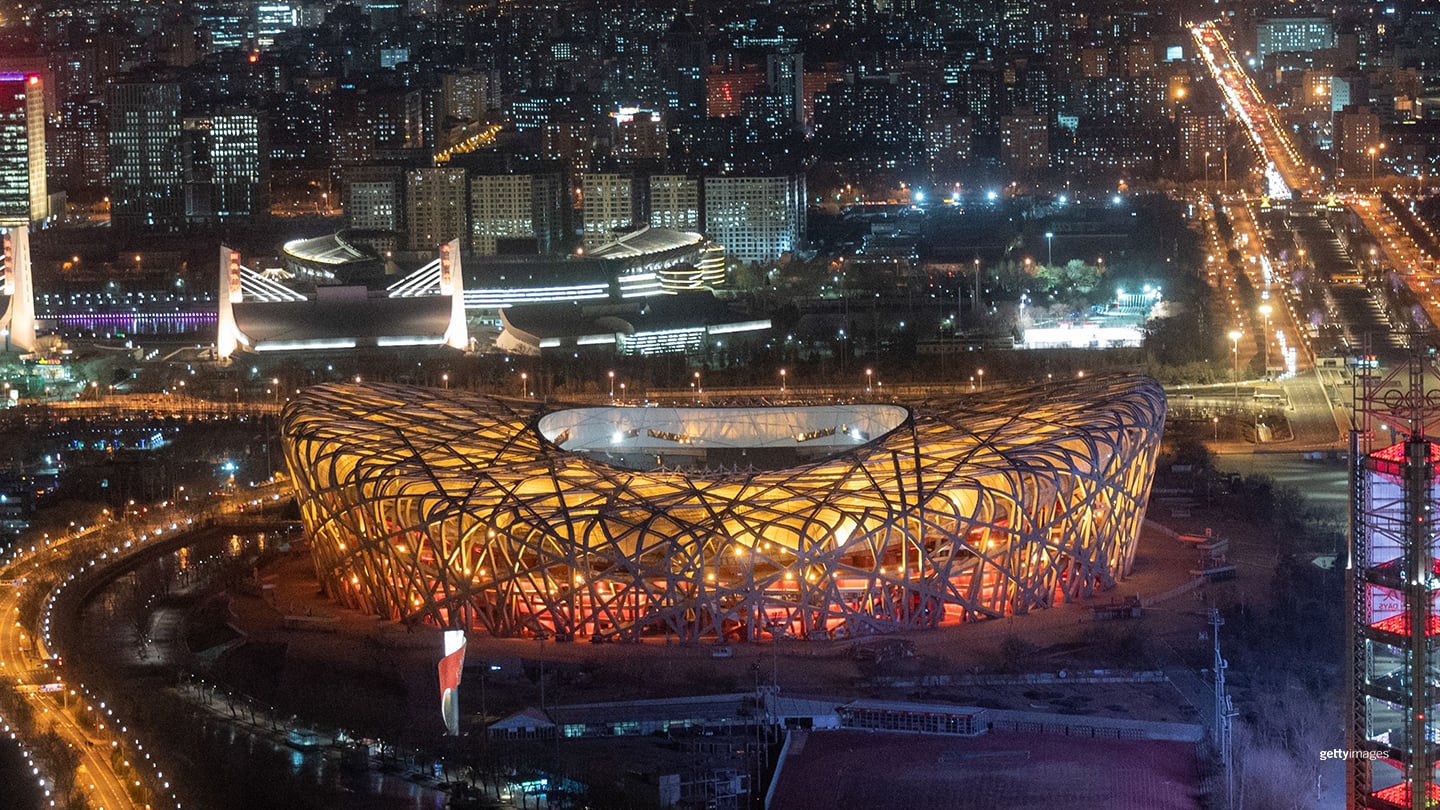
An Inside Look At The Three Zones Of The 2022 Winter Olympic Games
by Todd Kortemeier

A general view of Birds Nest stadium, the venue for Opening and Closing Ceremonies for the Olympic Winter Games Beijing 2022 on Feb. 3, 2021 in Beijing.
The Olympic Winter Games Beijing 2022 will look a little familiar to anyone who watched Beijing’s last Games in 2008 as athletes march into Beijing National Stadium — affectionately known as the “Bird’s Nest” — for the Opening Ceremony.
But take a closer look at the nearby venue known in 2008 as the “Water Cube” as host of most of the swimming and diving events. It’s now the “Ice Cube” and will host curling in 2022. The rest of the Games will feature a mix of old and new necessitated by the requirements of hosting such vastly different programs. That includes mountainous regions of the greater Beijing area that will expand the scope of the Games well beyond the city center.
Here’s a look at the three different zones where the world’s greatest athletes will compete in just 100 days.
Beijing Zone
Most of the Beijing 2022 venues are located on the Olympic Green, which contains the Bird’s Nest, the Ice Cube and several other venues that will be reused from the Olympic Games Beijing 2008. Ice hockey will be held inside the Beijing National Indoor Stadium (which hosted gymnastics, trampoline and handball in 2008). The only new venue constructed on the Olympic Green is the National Speed Skating Oval, occupying the site of the 2008 field hockey stadium.
Outside of the Olympic Green is the other arena that will host ice hockey, the Wukesong Sports Centre (home of basketball in 2008). Capital Indoor Stadium, which hosted volleyball in 2008, will host short track speedskating and figure skating. And Big Air Shougang, as clearly spelled out in its name, will host big air skiing and snowboarding, and is the world’s first permanent big air venue.
While 2008 Olympians also lived on the Olympic Green, those units became homes for Beijing residents in the aftermath of those Games. A new Olympic Village was constructed for 2022 just south of the Olympic Green. Completed in July 2021, it contains 2,300 beds for athletes and officials. Much like its 2008 counterpart, the Village will become apartments following the Games.

A staff member walks near the start line at the National Sliding Center built for the Olympic Winter Games Beijing 2022 on Feb. 5, 2021 in the Yanqing district of Beijing.
Yanqing Zone
The Yanqing District of Beijing is located just under 50 miles from the city center. It is known for its hot springs, a section of the Great Wall of China and most importantly, as far as the athletes of Team USA are concerned, ski resorts. The Yanqing Zone will host alpine skiing at the National Alpine Ski Centre, which consists of seven courses. Despite the prevalence of skiing in the area, Yanqing receives relatively little natural snow and will rely on artificial snow, something that Olympian Ryan Cochran-Siegle doesn’t expect will be an issue for the U.S. ski team.
“The majority of tracks I think that we ski on are artificially made, and they also do a lot of either watering or injecting with water to make it more of an icy surface,” Cochran-Siegle said. “So I don’t think there’s a whole lot of concern from our sports side of that kind of unnatural element to the Games, but I think we always kind of just have to face whatever’s thrown at us and adapt.”
Yanqing is also home of the National Sliding Centre, the first one in China. The 1.9-kilometer track has 16 turns and sleds will reach speeds of 130 to 140 kilometers per hour, according to U.S. driver Hunter Church. Church hasn’t yet been able to drive the track himself, but has been able to gather some intel from others.
“From what I’ve heard so far the track, and of course I’m going to jinx myself all of a sudden it’s going to be really difficult in February, but apparently it’s relatively simple to get down, but like most bobsled tracks it’s hard to get down fast,” said Church, who is seeking to compete in his first Olympic Games. “… It sounds like it’s a beautiful venue, the track itself has been quoted by some as being their favorite track so far, so it sounds like it’s going to be a really awesome Olympic track to go to.”
There is also a second Olympic Village in Yanqing for athletes in those sports. Designed to resemble a traditional Chinese mountain village, the facility can house 1,430 athletes and officials.

A general view of the athletes' village for the Olympic Winter Games Beijing 2022 on July 15, 2021 in Zhangjiakou, China.
Zhangjiakou Zone
Zhangjiakou is another skiing destination in the Beijing area, located more than 100 miles northwest of the city. Zhangjiakou will host all the other skiing and snowboarding events. Zhangjiakou will also have its own Olympic Village, capable of hosting 2,640 people. It will be reused as a business park in the years following the Games.
The area has hosted international skiing competitions before, such as at the Secret Garden resort, as two-time Olympic halfpipe skier Aaron Blunck recalled.
“I remember a lot about that. It was very interesting,” Blunck said. “It was one of the coldest places I’ve ever been on earth. Out of 10 days we were there the high was like negative 25 (and that) was the warmest day we had. So that was one thing that affected a lot of us. … I think if you just look at it like an open perspective, you’re one big open book, you're going to have a good time there.”
Todd Kortemeier is a sportswriter, editor and children’s book author from Minneapolis. He is a contributor to TeamUSA.org on behalf of Red Line Editorial, Inc.